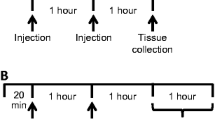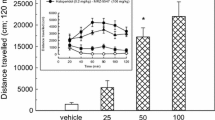Abstract
Striatal-enriched protein tyrosine phosphatase (STEP), which was initially identified in the striatum, is encoded by the Ptpn5 gene and is expressed in neurons of various structures of the brain. STEP is involved in regulating neuroplasticity, and its expression abnormalities are associated with human neurodegenerative disorders. The STEP inhibitor 8-trifluoromethyl-1,2,3,4,5-benzopentathiepin-6-amine hydrochloride (TC-2153) has been shown to affect the serotoninergic system of the brain. However, the influence of the serotoninergic system on the STEP regulation has not been studied yet. The aim of the study was to investigate how pharmacologically induced changes in the brain serotonin (5-HT) level affect Ptpn5 expression and STEP activity in adult male C57BL/6J mice. To modulate the 5-HT level in the brain, the 5-HT synthesis inhibitor p-chlorophenylalanine or 5-HT degradation inhibitor pargyline was administered intraperitoneally for three successive days. Changes in 5-HT concentration in the brain were assayed using high-performance liquid chromatography. The STEP activity was determined spectrophotometrically in the supernatant by the rate of p-nitrophenyl phosphate dephosphorylation in the absence and presence of the selective STEP inhibitor TC-2153. The Ptpn5 mRNA level was determined using quantitative RT-PCR. The Ptpn5 expression level in the striatum was three times higher than in the cortex and hippocampus. Both increases and decreases in brain 5-HT were for the first time associated with a decrease in Ptpn5 mRNA in the striatum. STEP activity in the striatum and cortex was significantly higher than in the hippocampus. However, p-chlorophenylalanine and pargyline did not affect the STEP activity in the brain structures tested. Thus, a new method was proposed to study the STEP activity in the brain and p-chlorophenylalanine and pargyline were shown to decrease Ptpn5 expression in the striatum in mice.




Similar content being viewed by others
REFERENCES
Venkitaramani D.V., Paul S., Zhang Y., Kurup P., Ding L., Tressler L., Allen M., Sacca R., Picciotto M.R., Lombroso P.J. 2009. Knockout of striatal enriched protein tyrosine phosphatase in mice results in increased ERK1/2 phosphorylation. Synapse. 63, 69‒81.
Pelov I., Teltsh O., Greenbaum L., Rigbi A., Kanyas-Sarner K., Lerer B., Lombroso P., Kohn Y. 2012. Involvement of PTPN5, the gene encoding the striatal-enriched protein tyrosine phosphatase, in schizophrenia and cognition. Psychiatr. Genet.22, 168‒176.
Goebel-Goody S.M., Baum M., Paspalas C.D., Fernandez S.M., Carty N.C., Kurup P., Lombroso P.J. 2012. Therapeutic implications for striatal-enriched protein tyrosine phosphatase (STEP) in neuropsychiatric disorders. Pharmacol. Rev.64, 65‒87.
Olausson P., Venkitaramani D.V., Morand T.D., Salterd M.W., Taylora J.R., Lombroso P.J. 2012. The tyrosine phosphatase STEP constrains amygdala-dependent memory formation and neuroplasticity. J. Neurosci.225, 1‒8.
Gladding C.M., Fan J., Zhang L.Y., Wang L., Xu J., Li E.H., Lombroso P.J., Raymond L.A. 2014. Alterations in striatal-enriched protein tyrosine phosphatase (STEP) expression, activation, and downstream signaling in early and late stages of the YAC128 Huntington’s disease mouse model. J. Neurochem.130, 145‒159.
Nguyen T.H., Liu J., Lombroso P.J. 2002. Striatal enriched phosphatase 61 dephosphorylates Fyn at phosphotyrosine 420. J. Biol. Chem.277, 24274‒24279.
Xu J., Kurup P., Bartos J.A., Patriarchi T., Hell J.W., Lombroso P.J. 2012. Striatal-enriched protein-tyrosine phosphatase (STEP) regulates Pyk2 kinase activity. J. Biol. Chem.287, 20942–20956.
Kurup P., Zhang Y., Xu J., Venkitaramani D.V., Haroutunian V., Greengard P., Nairn A.C., Lombroso P.J. 2010. A beta-mediated NMDA receptor endocytosis in Alzheimer’s disease involves ubiquitination of the tyrosine phosphatase STEP61. J. Neurosci.30, 5948‒5957.
Kulikov A.V., Gainetdinov R.R., Ponimaskin E., Kalueff A.V., Naumenko V.S., Popova N.K. 2018. Interplay between the key proteins of serotonin system in SSRI antidepressants efficacy. Expert Opin. Ther. Targets. 22, 319‒330.
Popova N.K., Naumenko V.S. 2019. Neuronal and behavioral plasticity: The role of serotonin and BDNF systems tandem. Expert Opin. Ther. Targets.23, 227‒239.
Lucki I. 1998. The spectrum of behavior influenced by serotonin. Biol. Psychiatry.44, 151‒162.
Walther D.J., Peter J.U., Bashammakh S., Hörtnagl H., Voits M., Fink H., Bader M. 2003. Synthesis of serotonin by a second tryptophan hydroxylase isoform. Science.299, 76.
Popova N.K., Kulikov A.V. 2010. Targeting tryptophan hydroxylase 2 in affective disorder. Expert Opin. Ther. Targets. 14, 1259‒1271.
Kulikov A.V., Popova N.K. 2015. Tryptophan hydroxylase 2 in seasonal affective disorder: Underestimated perspectives? Rev. Neurosci.26, 679‒690.
Kulikova E.A., Kulikov A.V. 2019. Tryptophan hydroxylase 2 as a therapeutic target for psychiatric disorders: Focus on animal models. Expert Opin. Ther. Targets.23, 655‒667.
Shih J.C., Thompson R.F. 1999. Monoamine oxidase in neuropsychiatry and behavior. Am. J. Hum. Genet. 65, 593‒598.
Allen D.L., Renner K.J., Luine V.N. 1993. Pargyline-induced increase in serotonin levels: Correlation with inhibition of lordosis in rats. Pharmacol. Biochem. Behav. 45, 837‒841.
Edmondson D.E., Mattevi A., Binda C., Li M., Hubálek F. 2004. Structure and mechanism of monoamine oxidase. Curr. Med. Chem.11, 1983‒1993.
Kulikova E.A., Bazhenova E.Y., Popova N.K., Khomenko T.M., Volcho K.P., Salakhutdinov N.F., Kulikov A.V. 2015. Effect of acute administration of 8-(trifluoromethyl)-1,2,3,4,5-benzopentathiepin-6-amine hydrochloride (TC-2153) on biogenic amines metabolism in mouse brain. Lett. Drug Design Discov.12, 833‒836.
Kulikov A.V., Tikhonova M.A., Kulikova E.A., Khomenko T.M., Korchagina D.V., Volcho K.P., Salakhutdinov N.F., Popova N.K. 2011. Effect of a new potential psychotropic drug, 8-(trifluoromethyl)-1,2,3,4,5-benzopentathiepin-6-amine hydrochloride, on the expression of serotonin-related genes in the mouse brain. Mol. Biol. (Moscow). 45 (2), 251‒257.
Kulikova E.A., Khotskin N.V., Illarionova N.B., Sorokin I.E., Bazhenova E.Y., Kondaurova E.M., Volcho K.P., Khomenko T.M., Salakhutdinov N.F., Ponimaskin E., Naumenko V.S., Kulikov A.V. 2018. Inhibitor of striatal-enriched protein tyrosine phosphatase, 8-(trifluoromethyl)-1,2,3,4,5-benzopentathiepin-6-amine hydrochloride (TC-2153), produces antidepressant-like effect and decreases functional activity and protein level of 5-HT(2A) receptor in the brain. Neuroscience.394, 220‒231.
Kulikov A.V., Naumenko V.S., Voronova I.P., Tikhonova M.A., Popova N.K. 2005. Quantitative RT-PCR assay of 5-HT1A and 5-HT2A serotonin receptor mRNAs using genomic DNA as an external standard. J. Neurosci. Methods.141, 97‒101.
Naumenko V.S., Osipova D.V., Kostina E.V., Kulikov A.V. 2008. Utilization of a two-standard system in real-time PCR for quantification of gene expression in the brain. J Neurosci. Methods. 170, 197‒203.
Khotskin N.V., Plyusnina A.V., Kulikova E.A., Bazhenova E.Y., Fursenko D.V., Sorokin I.E., Kolotygin I., Mormede P., Terenina E.E., Shevelev O.B., Kulikov A.V. 2019. On association of the lethal yellow (AY) mutation in the agouti gene with the alterations in mouse brain and behavior. Behav. Brain Res.359, 446‒456.
MacKintosh C., Moorhead G. 1993. Assay and purification of protein (serine/threonine) phosphatases. In: Protein Phosphorylation: A Practical Approach. Ed. Hardie D.G. New York: IRL Press, pp. 153‒182.
Kulikova E., Kulikov A. 2017. Striatal-enriched tyrosine protein phosphatase (STEP) in the mechanisms of depressive disorders. Curr. Protein Pept. Sci.18, 1152‒1162.
Mehta H., Saravanan K.S., Mohanakumar K.P. 2003. Serotonin synthesis inhibition in olivo-cerebellar system attenuates harmaline-induced tremor in Swiss albino mice. Behav. Brain Res. 145, 31‒36.
Dailly E., Chenu F., Petit-Demoulière B., Bourin M. 2006. Specificity and efficacy of noradrenaline, serotonin depletion in discrete brain areas of Swiss mice by neurotoxins. J. Neurosci. Methods.150, 111‒115.
Kornum B.R., Licht C.L., Weikop P., Knudsen G.M., Aznar S. 2006. Central serotonin depletion affects rat brain areas differently: A qualitative and quantitative comparison between different treatment schemes. Neurosci. Lett. 392, 129‒134.
Izumi T., Iwamoto N., Kitaichi Y., Kato A., Inoue T., Koyama T. 2006. Effects of co-administration of a selective serotonin reuptake inhibitor and monoamine oxidase inhibitors on 5-HT-related behavior in rats. Eur. J. Pharmacol.532, 258‒264.
Lima F.B., Szawka R.E., Anselmo-Franci J.A., Franci C.R. 2007. Pargyline effect on luteinizing hormone secretion throughout the rat estrous cycle: Correlation with serotonin, catecholamines and nitric oxide in the medial preoptic area. Brain Res.1142, 37‒45.
Fisar Z., Hroudová J., Raboch J. 2010. Inhibition of monoamine oxidase activity by antidepressants and mood stabilizers. Neuro Endocrinol. Lett.31, 645‒656.
Kulikov A.V., Osipova D.V., Naumenko V.S., Terenina E., Mormède P., Popova N.K. 2012. A pharmacological evidence of positive association between mouse intermale aggression and brain serotonin metabolism. Behav. Brain Res.233, 113‒119.
Roth B.L. 2011. 5-HT(2A) serotonin receptor biology: Interacting proteins, kinases and paradoxical regulation. Neuropharmacology. 61, 348‒354.
Shimizu S., Tatara A., Imaki J., Ohno Y. 2010. Role of cortical and striatal 5-HT1A receptors in alleviating antipsychotic-induced extrapyramidal disorders. Prog. Neuropsychopharmacol. Biol. Psychiatry.34, 877‒881.
Borsini F. 1995. Role of the serotonergic system in the forced swimming test. Neurosci. Biobehav. Rev.19, 377‒395.
Nagayama H., Tsuchiyama K., Yamada K., Akiyoshi J. 1991. Animal study on the role of serotonin in depression. Prog. Neuropsychopharmacol. Biol. Psychiatry.15, 735‒744.
Jacobsen J.P., Medvedev I.O., Caron M.G. 2012. The 5-HT deficiency theory of depression: Perspectives from a naturalistic 5-HT deficiency model, the tryptophan hydroxylase 2Arg439His knockin mouse. Philos. Trans. R. Soc., B.367, 2444‒2459.
Shah R., Courtiol E., Castellanos F.X., Teixeira C.M. 2018. Abnormal serotonin levels during perinatal development lead to behavioral deficits in adulthood. Front. Behav. Neurosci.12, 114.
Kulikova E.A., Volcho K.P., Salakhutdinov N.F. and Kulikov A.V. 2017. Benzopentathiepine derivative, 8‑(trifluoromethyl)-1,2,3,4,5-benzopentathiepin-6-amine hydrochloride (TC-2153), as a promising antidepressant of new generation. Lett. Drug Des. Discov.14, 974‒984.
Kulikov A.V., Tikhonova M.A., Kulikova E.A., Volcho K.P., Khomenko T.M., Salakhutdinov N.F., Popova N.K. 2014. Antidepressant activity of 8-(trifluoromethyl)-1,2,3,4,5-benzopentathiepin-6-amine hydrochloride (TC-2153): Comparison with classical antidepressants. Lett. Drug Des. Discov.11, 169‒173.
Kulikova E.A., Tikhonova M.A., Volcho K.P., Khomenko T.M., Salakhutdinov N.F., Kulikov A.V., Popova N.K. 2015. Comparison of psychotropic effects of fluoxetine, imipramine, and the new psychotropic drug TC-2153 in mice differing in hereditary predisposition to catalepsy. Zh. Vyssh. Nerv. Deyat.im.I.P. Pavlova.65, 105‒112.
ACKNOWLEDGMENTS
We are grateful to researchers of the Laboratory of Physiologically Active Compounds (headed by Doct. Sci. (chem.), Prof. N.F. Salakhutdinov) of the Vorozhtsov Novosibirsk Institute of Organic Chemistry (Siberian Branch, Russian Academy of Sciences) for kindly providing TC-2153.
Funding
This work was supported by the Russian Science Foundation (project no. 17-15-01032). The breeding and rearing of animals were supported by a budgetary program for young researchers (project no. 0259-2019-0002) and were carried out using equipment of the Collective Access Center of Genetic Resources of Laboratory Animals (Institute of Cytology and Genetics), which was supported by the Ministry of Education and Science of the Russian Federation (unique project identifier RFMEFI62119X0023).
Author information
Authors and Affiliations
Corresponding author
Ethics declarations
Conflict of interests. The authors declare that they have no conflict of interest.
Statement on the welfare of animals. Animal rearing conditions and experimental procedures followed the guidelines established by The Directive 2010/63/EU of the European Parliament and the Council of 22 September 2010 and were approved by the Ethics Committee at the Institute of Cytology and Genetics.
Additional information
Translated by T. Tkacheva
Abbreviations: 5-HT, serotonin; Ptpn5, the STEP gene; Polr2a, DNA-directed RNA polymerase II; STEP, striatal-enriched protein tyrosine phosphatase; MAOA, monoamine oxidase A; TPH2, tryptophan hydroxylase 2.
Rights and permissions
About this article
Cite this article
Kulikova, E.A., Fursenko, D.V., Bazhenova, E.Y. et al. Pargyline and р-Chlorophenylalanine Decrease Expression of Ptpn5 Encoding Striatal-Enriched Protein Tyrosine Phosphatase (STEP) in the Mouse Striatum. Mol Biol 54, 274–280 (2020). https://doi.org/10.1134/S0026893320020090
Received:
Revised:
Accepted:
Published:
Issue Date:
DOI: https://doi.org/10.1134/S0026893320020090




